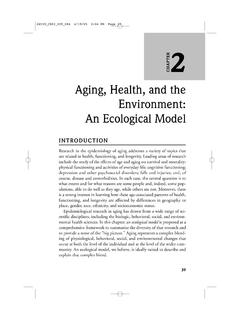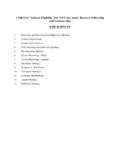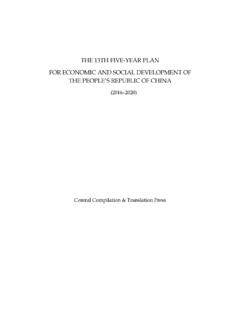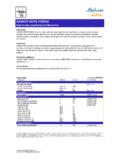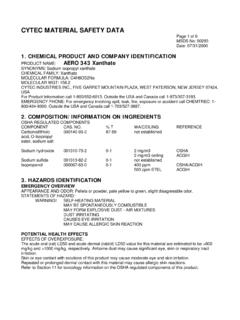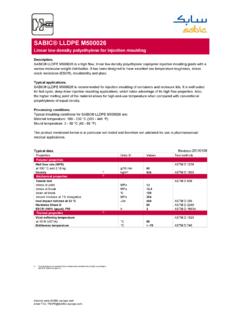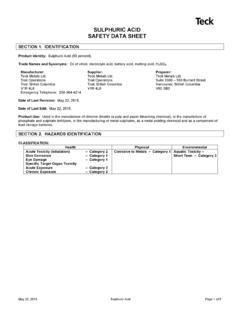Transcription of Bronfenbrenner’s Ecological Systems Theory
1 BronfenbrennerBronfenbrenner s Ecological Systems Theory Dede Paquette John Ryan Ecological Systems Theory :This Theory looks at a child s development within the context of the system of relationships that form his or her environment . Bronfenbrenner s Theory defines complex layers of environment , each having an effect on a child s development. This Theory has recently been renamed bioecological Systems Theory to emphasize that a child s own biology is a primary environment fueling her development. The interaction between factors in the child s maturing biology, his immediate family/community environment , and the societal landscape fuels and steers his development. Changes or conflict in any one layer will ripple throughout other layers. To study a child s development then, we must look not only at the child and her immediate environment , but also at the interaction of the larger environment as various terms in this graphic are links that lead to pages explaining their implications in this :///C|/My%20 Documents/My%20 Webs/Bronfnebrenner%20 (1 of 4) [7/12/2001 6:36:39 PM]Bronfenbrenner Bronfenbrenner s structure of environment : The microsystem this is the layer closest to the child and contains the structures with which the child has direct contact.
2 The microsystem encompasses the relationships and interactions a child has with her immediate surroundings (Berk, 2000). Structures in the microsystem include family, school, neighborhood, or childcare environments. At this level, relationships have impact in two directions - both away from the child and toward the child. For example, a child s parents may affect his beliefs and behavior; however, the child also affects the behavior and beliefs of the parent. Bronfenbrenner calls these bi-directional influences, and he shows how they occur among all levels of environment . The interaction of structures within a layer and interactions of structures between layers is key to this Theory . At the microsystem level, bi-directional influences are strongest and have the greatest impact on the child. However, interactions at outer levels can still impact the inner structures. The mesosystem this layer provides the connection between the structures of the child s microsystem (Berk, 2000).
3 Examples: the connection between the child s teacher and his parents, between his church and his neighborhood, etc. The exosystem this layer defines the larger social system in which the child does not function directly. The structures in this layer impact the child s development by interacting with some structure in her microsystem (Berk, 2000). Parent workplace schedules or community-based family resources are examples. The child may not be directly involved at this level, but he does feel the positive or negative force involved with the interaction with his own system. The macrosystem this layer may be considered the outermost layer in the child s environment . While not being a specific framework, this layer is comprised of cultural values, customs, and laws (Berk, 2000). The effects of larger principles defined by the macrosystem have a cascading influence throughout the interactions of all other layers. For example, if it is the belief of the culture that parents should be solely responsible for raising their children, that culture is less likely to provide resources to help parents.
4 This, in turn, affects the structures in which the parents function. The parents ability or inability to carry out that responsibility toward their child within the context of the child s microsystem is likewise affected. The chronosystem this system encompasses the dimension of time as it relates to a child s environments. Elements within this system can be either external, such as the timing of a parent s death, or internal, such as the physiological changes that occur with the aging of a child. As children get older, they may react differently to environmental changes and may be more able to determine more how that change will influence them. Nature vs. Nurture? More modern child development theories accept that both a child s biology and his environment play a role in change and growth. Theories now focus on the role played by each and the extent to which they interact in ongoing file:///C|/My%20 Documents/My%20 Webs/Bronfnebrenner%20 (2 of 4) [7/12/2001 6:36:39 PM]Bronfenbrennerdevelopment.
5 Bronfenbrenner s Ecological Systems Theory focuses on the quality and context of the child s environment . He states that as a child develops, the interaction within these environments becomes more complex. This complexity can arise as the child s physical and cognitive structures grow and mature. So, given that nature continues on a given path, how does the world that surrounds the child help or hinder continued development? This is the question answered by Bronfenbrenner s Theory . Urie Bronfenbrenner, co-founder of Head Start, uses his bioecological model to provide a startlingly clear view of the problems we have been seeing in our students and in our families. He says that technology has changed our society, and while we are taking great pains to safeguard the physical environment from the damage done by a technology, we have spent no resources to provide similar safeguards to the damage done to our societal environment . (Henderson, 1995). Our economy has shifted from an industrial model to a technological model, yet the patterns of the workplace have continued to rely on the factory work ethic.
6 Parents are expected to work a schedule that revolves around the factory whistle even though they may work in a high tech office. The technology that enables workers to be free of manual labor, should also free them from the time and place boundary. Yet, our work ethic demands more face time not less. As women entered the work force, they too were subject to the same demands. Family life in this country has taken a back seat to the needs of the workplace. Also of concern to Bronfenbrenner is the deficit model used to determine the level of support granted by the public to struggling families. Parents must declare themselves deficient in some way in order to qualify for help in solving problems that may come about because of our cultural value of independence. A larger degree of failure means a larger amount of support. By working from this deficit model, we expect families to hold their hands up from deep inside a black hole of helplessness. Then, we expect them to have the psychological strength to climb up the thin rope the throw down.
7 Implications for practiceBronfenbrenner sees the instability and unpredictability of family life we ve let our economy create as the most destructive force to a child s development (Addison, 1992). Children do not have the constant mutual interaction with important adults that is necessary for development. According to the Ecological Theory , if the relationships in the immediate microsystem break down, the child will not have the tools to explore other parts of his environment . Children looking for the affirmations that should be present in the child/parent (or child/other important adult) relationship look for attention in inappropriate places. These deficiencies show themselves especially in adolescence as anti-social behavior, lack of self-discipline, and inability to provide self-direction (Addison, 1992). This Theory has dire implications for the practice of teaching. Knowing about the breakdown occurring within children s homes, is it possible for our educational system to make up for these deficiencies?
8 It seems now that it is necessary for schools and teachers to provide stable, long-term relationships. Yet, Bronfenbrenner believes that the primary relationship needs to be with someone who can provide a sense of caring that is meant to last a lifetime. This relationship must be fostered by a person or people within the immediate sphere of the child s influence. Schools and teachers fulfill an important secondary role, but cannot provide the complexity of interaction that can be provided by primary adults. For the educational community to attempt a primary role is to help our society continue its denial of the real issue. The problems students and families face are caused by the conflict between the workplace and family life not between families and schools. Schools and teachers should work to support the primary relationship and to create an environment that welcomes and nurtures families. We can do this while we work to realize Bronfenbrenner s ideal of the creation of public policy that eases the work/family conflict (Henderson, 1995).
9 It is in the best interest of our entire society to lobby for political and economic policies that support the importance of parent s roles in their children s development. Bronfenbrenner would also agree that we should foster societal attitudes that value work done on behalf of children at all levels: parents, teachers, extended family, mentors, work supervisors, :///C|/My%20 Documents/My%20 Webs/Bronfnebrenner%20 (3 of 4) [7/12/2001 6:36:39 PM]BronfenbrennerReferencesAddison, J. T. (1992). Urie Bronfenbrenner. Human Ecology, 20(2), , (2000). Child Development (5th ed.). Boston: Allyn and Bacon. 23-38 Bronfenbrenner, U. (1990). Discovering what families do. In Rebuilding the Nest: A New Commitment to the American Family. Family Service America [web site]. < >Henderson, Z. P. (1995). Renewing our social fabric. Human Ecology, 23(1), 16-19. Made with MS FrontPage by Dede Paquette and John Ryan for National-Louis University file:///C|/My%20 Documents/My%20 Webs/Bronfnebrenner%20 (4 of 4) [7/12/2001 6:36:39 PM]The BodyThe Body Anatomy is destiny Sigmund Freud, Collected Writings (1924) vol.
10 5 In the bioecological Systems approach of Bronfenbrenner, the body is part of the microsystem. Its effects on the other parts of the microsystem are probably obvious to most of us. The body is the life support system, the mobility system, and that with which we perceive and interact with the are several characteristics of the body that can influence development in different ways. The first and broadest is the general health of the body. A person s health is determined by how effectively the various subsystems in the body function and the influences of environmental factors. The complexity of the human body is well beyond the discussion here; from genes to biochemical reactions on the cellular level, from enzymes to proteins, and from bones to skin, we are an amazing collection of compounds and structures. If all our Systems are working together and effectively, we can say we are in good health. Unfortunately this is a rather rare are many more disorders of the body than there are of the mind, and some affect both.

